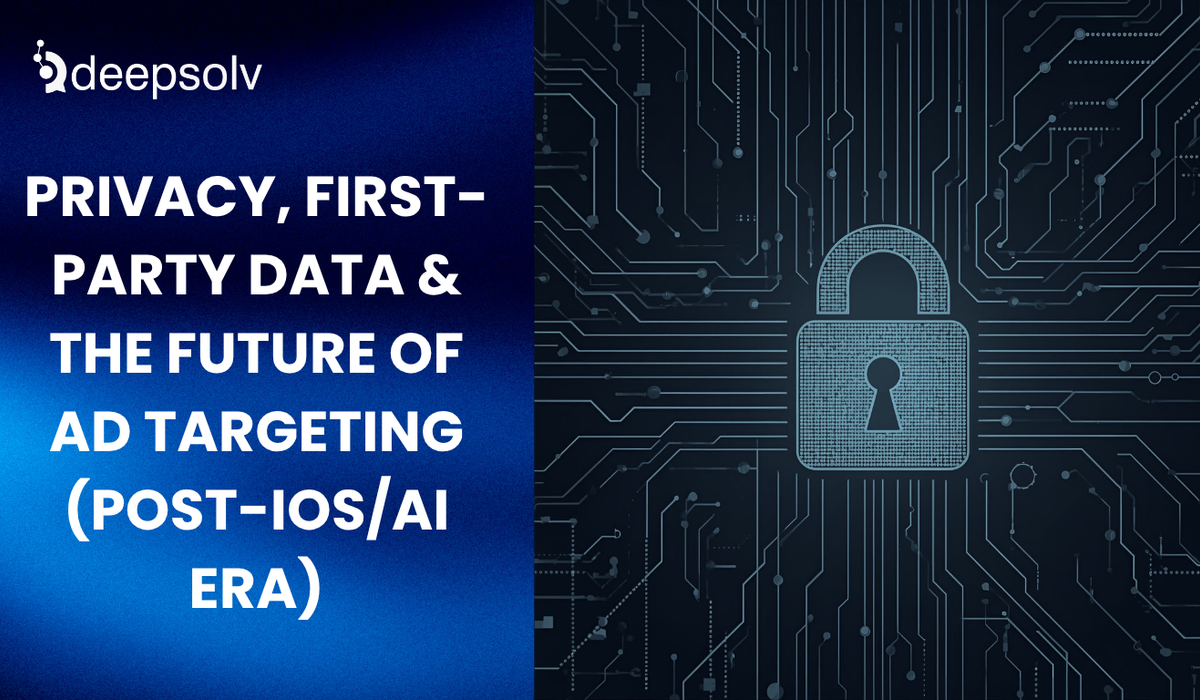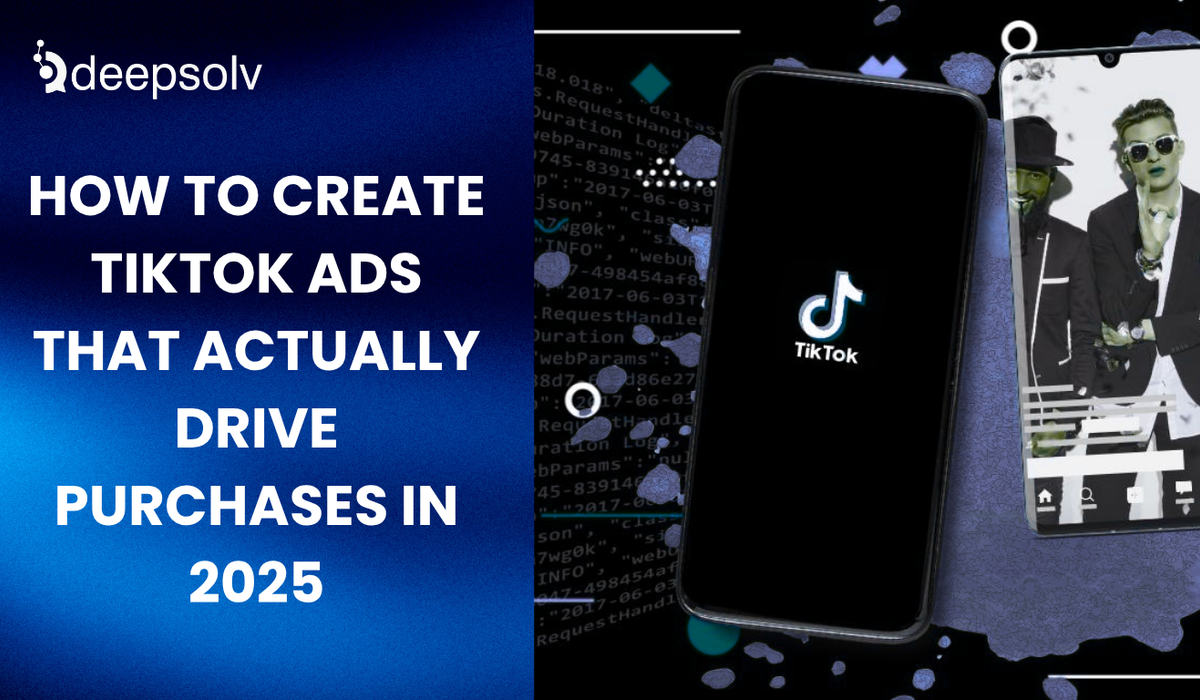Privacy, First-Party Data & the Future of Ad Targeting (Post-iOS/AI Era)
6 min read
Published: 10/20/2025

Introduction: The End of Easy Targeting
There was a time when advertisers could target anyone, anywhere, based on every click and scroll. Those days are gone.
Since Apple’s iOS 14 update, Google’s gradual phaseout of third-party cookies, and new privacy laws (GDPR, DPDP, CCPA), marketers have entered a new era — one defined by data scarcity and consumer control.
But while this seems like a loss, it’s actually the biggest reset opportunity in digital advertising history.
The brands winning in 2025 aren’t those with the biggest budgets, they’re those with the smartest data ecosystems. They’re combining first-party data, AI intelligence, and privacy compliance to personalize without invading.
In this guide, we’ll break down:
- What the post-iOS era really means for advertisers
- How AI is rebuilding targeting models from zero-party and first-party data
- How real brands are adapting
And why Creative Intelligence Platforms like Deepsolv are leading this next phase of ad strategy.
The iOS Shockwave: How Privacy Redefined Digital Advertising
When Apple launched App Tracking Transparency (ATT) in 2021, over 96% of users opted out of tracking. Suddenly, platforms like Meta, Google, and TikTok lost access to user-level data that powered personalized ads.
What this meant:
- Conversion events became harder to attribute
- Lookalike audiences weakened
- Retargeting accuracy dropped
- CPMs rose as ad algorithms worked with incomplete data
Marketers called it the “blackout period.”
But in 2025, the dust has settled and a new paradigm has emerged: 👉 Privacy-first advertising, powered by first-party data and AI prediction models.
What Is First-Party Data and Why It’s Now Everything
First-party data is any data you collect directly from your customers ethically and transparently.
Examples:
- Email sign-ups
- Website visits
- App interactions
- Purchase history
- Customer service chats
- Social DMs or engagement data
Unlike third-party data (bought from external sources), first-party data is owned by you and thus remains compliant, high-quality, and privacy-safe.
In the post-iOS era, this ownership isn’t just valuable — it’s survival.
Zero-Party vs. First-Party Data: The Subtle Shift
In 2025, we’re also seeing the rise of zero-party data — information that customers willingly provide. This includes quiz responses, feedback forms, polls, and preferences shared during conversations.
When combined with first-party behavioral data, it creates a rich, consent-based profile of your customer, one that’s far more accurate than legacy tracking.
💡 Example: A skincare brand replaced pixel tracking with an in-app quiz asking about skin type, age, and concerns. This self-reported data became its targeting foundation generating 43% higher ROAS than previous lookalike models.
The AI Pivot: How Machine Learning Rebuilds Targeting
Here’s the paradox: as individual data shrinks, AI’s role expands.
AI models are now learning to:
- Predict intent from minimal signals (like session duration, creative engagement, dwell time)
- Model behavior across anonymized groups, not individuals
- Identify pattern similarities within first-party datasets
- Rebuild lookalike audiences using probabilistic, not deterministic, data
Platforms like Meta, Google, and TikTok are already implementing this via AI-driven campaign automation — think Meta Advantage+, Google Performance Max, and TikTok Smart Targeting.
But here’s the catch: these systems still rely on your first-party data input quality. Feed them the right signals, and they perform brilliantly. Feed them poor or incomplete data, and your ROAS collapses.
That’s where Creative Intelligence Platforms like Deepsolv come in bridging your audience data with creative and emotional insights to give AI systems richer, more human-relevant inputs.
How Creative Intelligence Enhances First-Party Targeting
Traditional ad systems analyze behavior. Creative Intelligence Platforms analyze emotion, context, and meaning.
When you connect your first-party data (site visits, DMs, engagement) with a platform like Deepsolv, AI Strategists (like Adam and Brandy) don’t just see “what users did” — they understand why.
Deepsolv’s First-Party Data Loop
- Capture: Collect clean data from your site, app, and social channels.
- Analyze: Identify emotional drivers behind engagement (trust, curiosity, urgency).
- Optimize: Personalize ad creatives and offers for each segment.
- Measure: Link engagement loops back to purchase behavior.
This creates a self-learning cycle — your ads continuously adapt to your customers’ evolving preferences without invading privacy.
It’s not just targeting — it’s data-driven empathy.
New Targeting Frameworks for the Privacy-First Era
Let’s look at how targeting works now, post-iOS.
| Old World (Pre-iOS) | New World (Post-iOS + AI) |
| Third-party cookies | First-party and zero-party data |
| Individual-based tracking | Group-based behavior modeling |
| Manual retargeting | Predictive AI retargeting |
| Lookalike audiences | Signal-based audience clustering |
| Conversion pixels | Server-side event tracking |
| Data collection | Data consent & collaboration |
Takeaway: Success now depends on what you own, not what you rent.
Real-World Examples of First-Party Data in Action
1. Nike – Building Its Own Data Ecosystem
When Apple’s privacy update hit, Nike leaned fully into owned data. Through its Nike app ecosystem (Run Club, Training Club, SNKRS), it gathered direct behavior, preferences, and purchase data bypassing third-party reliance.
Result:
- 65% of digital sales now come from logged-in users
- Ad personalization improved despite reduced external tracking
- Nike’s cost per acquisition dropped 23%
By owning the customer relationship, Nike turned data privacy into an advantage.
2. Deepsolv x DTC Beauty Brand – Predictive Personalization
A D2C skincare client used Deepsolv’s Creative Intelligence Platform to connect social engagement data with CRM and purchase logs. Adam (AI Strategist) analyzed emotional response patterns from ad comments and mapped them to repeat purchase likelihood.
What happened:
- Found that “confidence-driven” creatives led to 1.8x higher lifetime value (LTV)
- Shifted budget toward those ad types
- Overall ROAS increased by 52% in 45 days
This wasn’t based on personal tracking — just emotional intelligence built on first-party engagement.
3. Sephora – Loyalty-Driven First-Party Targeting
Sephora’s Beauty Insider program collects explicit preferences and feedback. This zero-party data feeds into their Meta and TikTok ad models via server-side APIs.
Impact:
- Lookalike modeling accuracy improved 33%
- Ad spend efficiency increased 28%
- Personalized offers saw 2.4x higher CTR
By turning loyalty into data, Sephora future-proofed its targeting in a privacy-first landscape.
Emerging Technologies Shaping the Future of Ad Targeting
2025 is the year where privacy and personalization finally coexist — thanks to new tech frameworks like:
1. Clean Rooms
Secure environments (e.g., Meta’s Advanced Data Clean Room) allow advertisers to compare datasets with platforms without sharing personal data. You get insights like purchase overlap or cross-platform frequency without breaching privacy laws.
2. Server-Side Tracking
Instead of browser-based cookies, data is now passed directly from servers (using Meta’s Conversions API or Google Enhanced Conversions) improving accuracy and privacy.
3. Federated Learning
AI models train on user devices, not on centralized data, allowing predictive modeling while keeping personal data local.
4. Consent-Based Personalization
Brands now incentivize users to share data voluntarily through loyalty programs, exclusive access, or personalized recommendations.
Challenges Ahead: Balancing Privacy, Performance, and Trust
While first-party data solves the targeting gap, it brings new challenges:
- Managing consent and transparency
- Integrating fragmented data sources
- Avoiding over-personalization creepiness
- Ensuring compliance with evolving laws (GDPR 2.0, India DPDP, U.S. Privacy Act)
This is where Creative Intelligence matters most — ensuring personalization feels human, not robotic.
Deepsolv’s Role in the Post-iOS Future
Deepsolv is not an automation tool — it’s a Creative Intelligence Platform built for the privacy-first, AI-powered ad era.
Its AI Strategists — Adam (Creative Intelligence) and Brandy (Engagement Intelligence) — help brands:
- Decode emotional intent from first-party engagement
- Predict high-performing ad narratives using anonymized behavioral data
- Integrate with Clean Rooms & APIs to maintain compliance
- Automate creative refreshes before fatigue sets in
The result: hyper-relevant ad experiences that convert — without violating trust.
Conclusion: The Future Belongs to Data-Intelligent, Privacy-Respectful Brands
The future of ad targeting isn’t about knowing who your customer is. It’s about understanding what they care about — without crossing ethical lines.
Privacy-first marketing, powered by first-party data and AI, is not a limitation. It’s an upgrade.
By building your own audience ecosystem and feeding it into Creative Intelligence systems like Deepsolv, you can:
- Stay compliant
- Stay competitive
- And most importantly — stay connected to your customers in meaningful, human ways.
⚡ Book a Free Data Intelligence Audit
Want to future-proof your targeting strategy? Schedule a free strategy session with Deepsolv’s AI Strategists and we’ll analyze your current data ecosystem, identify compliance gaps, and design a privacy-first ad model that scales ROI safely.
⏳ Only a few free audits left this month — claim your spot before your next campaign run.
FAQs
Frequently asked questions related to this blog post


